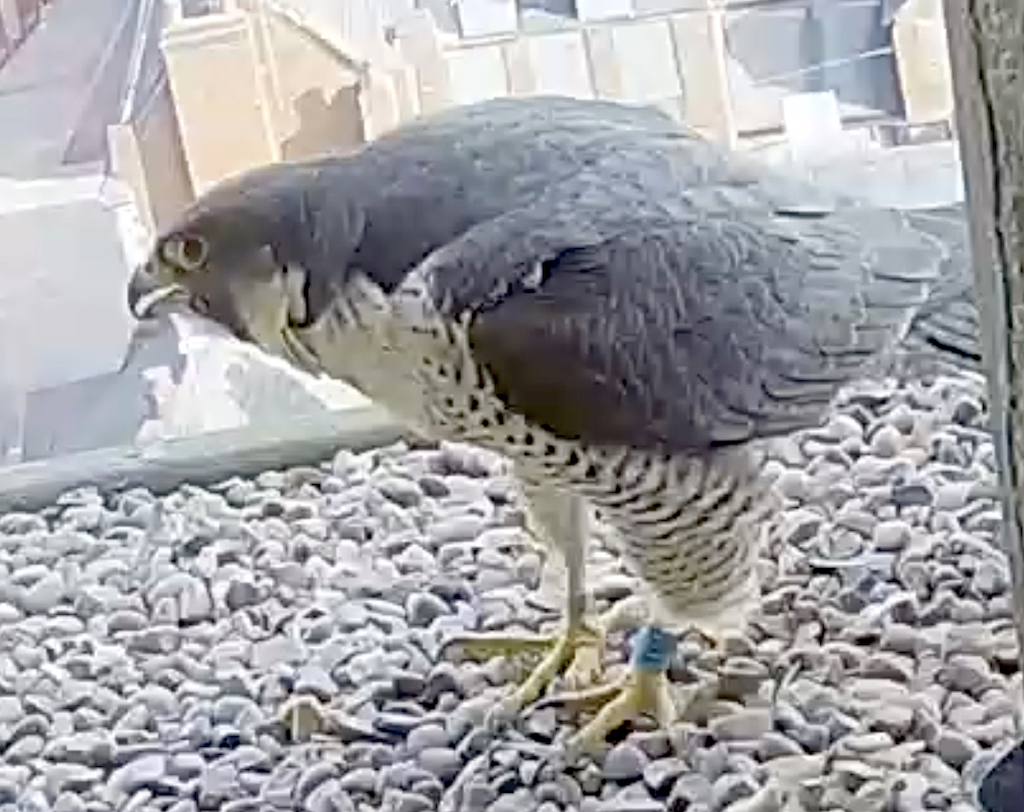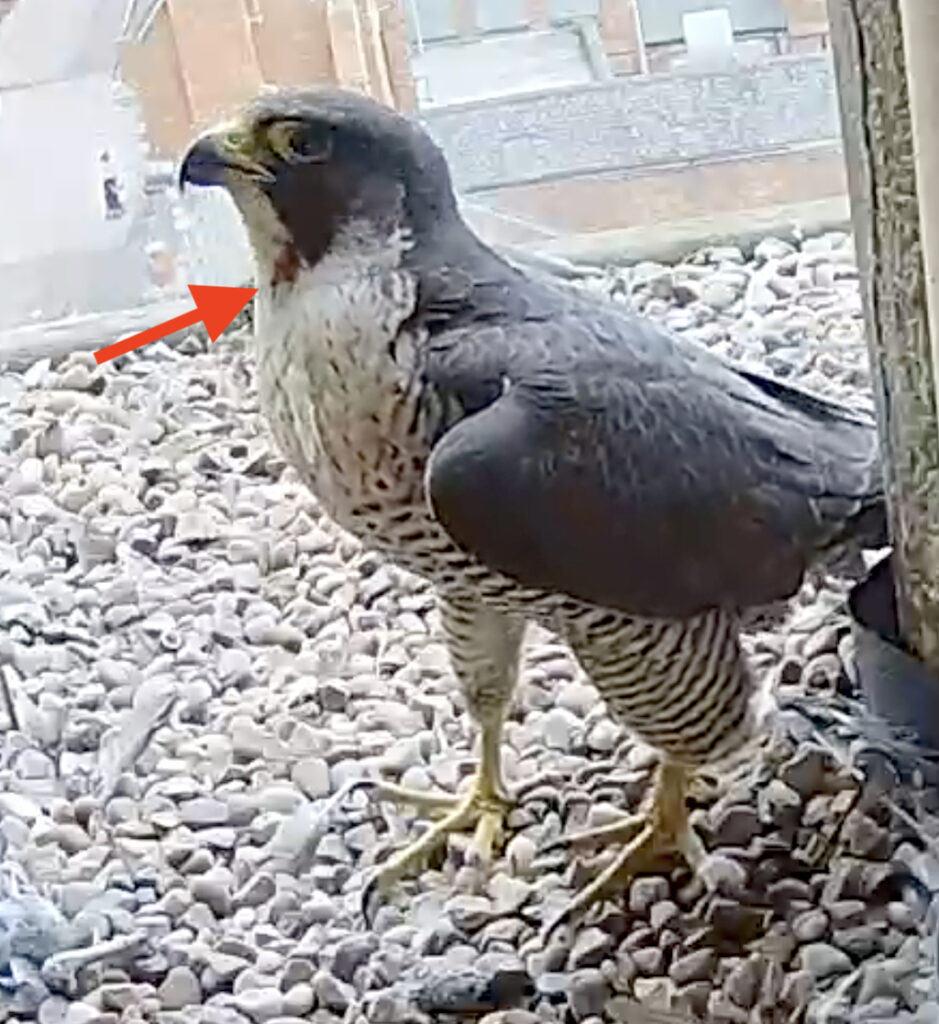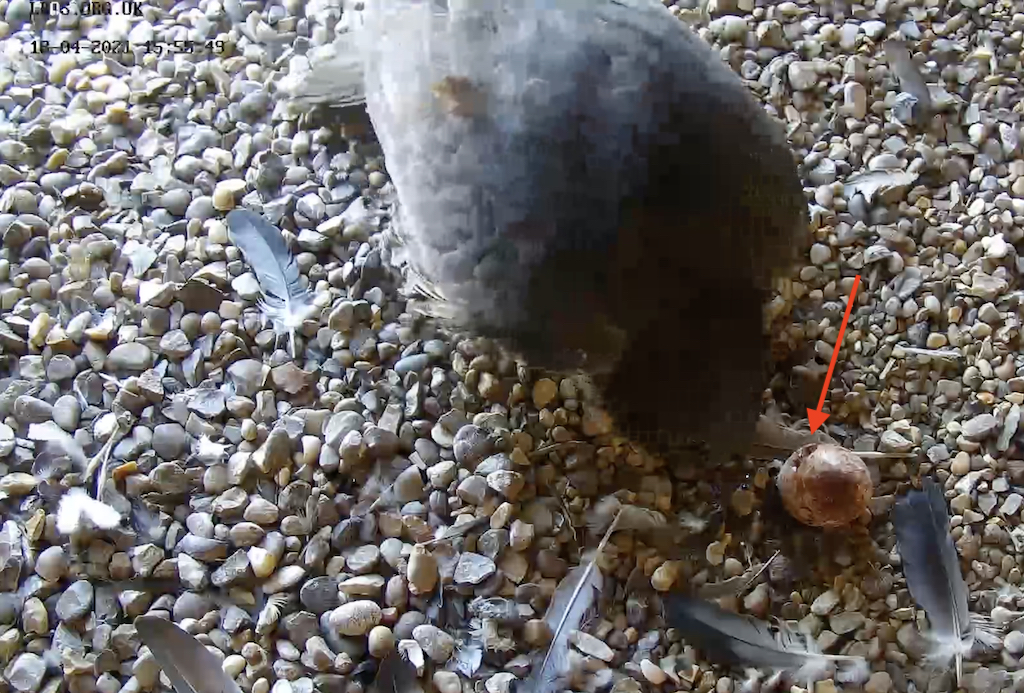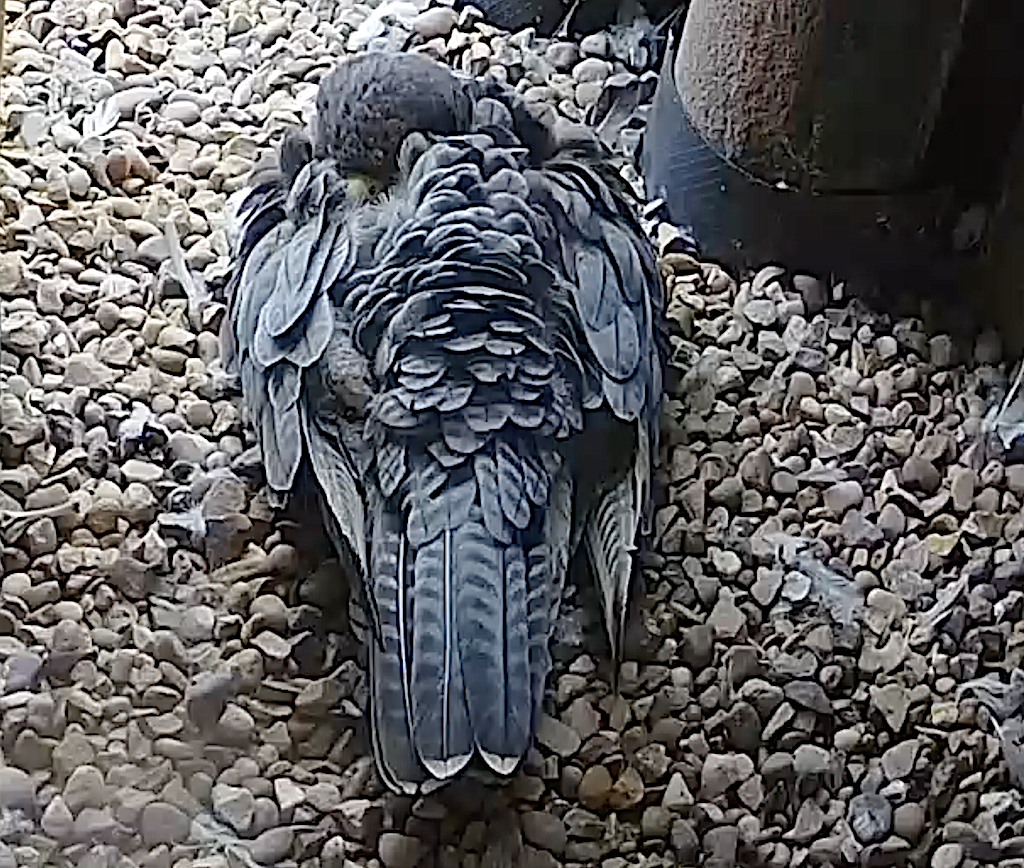To see a log of current events and activities please visit the Daily Commentary Page or for older information please the Archive Page.
Video Snippets and news from the 2021 breeding season.
The 2021 Season
The pair continued there bonding through January and tending the scrape most days. However, on there was agitated behaviour noted on 7th January and the following day another new female was seen on the nesting ledge – the fourth different female in less than a year. Over the next few days the pair defend their site and appear to repel the intruder. During the second half of January, the male brings in prey items for the female, trying to ensure she is in the best breeding condition.

The feeding and bonding activity continued through February with frequent visits to the box and tidying of the scrape. Everything seemed calm until 18th February with another female landed in the box – the 5th in 12 months. The male was in residence but quickly flew out. The intruder remained for just a few minutes, seen to be wearing a blue-ring and considered to be the non-breeding resident female from Market Harborough. Later in the afternoon, the pair resumed their bonding. However, at 18:15 the male flies in followed by yet another different female, this time un-ringed. He quickly flies off whilst she remains for 30 minutes. She makes two more visits to the box and is confronted by the resident orange-ringed female at 21:30. The resident bird forces the intruder out of the box and returns a few minutes later and remains on the ledge for the rest of the evening. The pair spent more time on the platform and things calmed down again until 22nd February when activity suggested an intruder in the area but no sightings were caught on camera until the 25th when the un-ringed female is in the box with the male and there is posturing between the two at 23:15. He flies out when she gets too close but she remains for 20 minutes when she is disturbed by the resident female and flies out. However, the un-ringed bird is back at midnight. Surprisingly, the male lands with an item of prey and the female pursues him out of the box. During the next six hours the male and un-ringed female spend time together in the box posturing, calling and bonding. At 6:25, just ten minutes after flying off with the un-ringed female, the male is back with the orange-ringed resident female for 15 minutes bonding. He returns with the un-ringed female at 8:10 and the orange-ringed bird at 8:25 and 10:50. It seems that the male is keeping his options open bonding with two females at the same time. Neither female is seen for the rest of the day. The following morning, the resident female is bonding with the male.

During the first ten days weeks of March the pair continued to bond. However, the un-ringed female is still around and is seen in the box with the male on the 4th and 6th. On the 9th, the intruding female spends more time on the platform and makes seven short flights in a 15 minute period from 13:10 and finally returns with the male. From 15:00 to 18:00, the un-ringed female chases the male into the box on 14 occasions. The following morning the un-ringed bird is in the box bonding with the male. During the day she is seen feeding on the platform and stashing food in the box. It is now apparent that the un-ringed female has ousted the orange-ringed bird despite being paired to the male since September 2020 and the original female is not seen on camera again. Over the rest of the month there is increased activity on the platform with the new pairing paying frequent visits and remaining longer. The male continued to bring in more food for the new female. On the 17th, she spends an hour and 40 minutes in the scrape – the longest time so far. All seemed calm until the 23rd when the pair started acting agitated making 15 short flight between 7:00 and 9:00 with a number of close flight by a third bird – a female. The intruding bird flies towards the new female at 9:40. They engage talons and fall to the ground. A local resident films the birds grappling on the ground in a nearby courtyard. When the female returns to the platform it is noticeable that she has blood on her neck. The rest of the day the pair was trying to fend off the intruding female. I happened to be in Leicester city briefly in the afternoon and saw the male buzzing the intruding female which looked to have slight damage to one leg. The pair continually forcing the intruder out of the area, only for it to return five or ten minutes later and was even sitting on the spire. At 13:45, the two females had their talons engaged and were falling to the ground over St. Martins House; they were both back in the air not too long after. Things seemed to have calmed down a little by 17:45 when the female returns with some stashed prey. The pair continue to bond and feed with the female tending the scrape and there appears to be no more intrusions until the morning of the 27th when a number of sorties are made as an intruding female is seen once again. We do not know if this is the previous orange-ringed bird or yet another female, as no rings could be viewed. The afternoon was much calmer to the extent that at 15:25 copulation was noted on camera for the first time with a second attempt the following day at 17:45. There is more intruder activity on the 29th and the two females are seen with locked talons falling to the ground at 9:55. The pair are soon back on the ledge but there are 14 sorties in the next three hours and a further 14 between 15:00 and 17:00. The latest intruder has obviously not gone away and is seen again on the 31st at 7:25 although the chasing was minimal.
The pair continued to bond through early April with mating noted on the spire crosses and the female spending increasingly longer in the box. In the previous five years, the first egg of the season has normally been laid in the last week of March. This has no doubt been delayed due to the very late forming of this pair.
The male brings in numerous prey items for the female to help her reach peak breeding condition. All seemed quiet on the intruder front until 9th April when the pair made 21 sorties from the platform between 9:00 and 12:00, after which everything settles down again until the 15th when further evidence of intruder activity including late at night. At 10:30 on 17th April, the female lays the first egg of the season. The male is shown it and 20 minutes later has his first incubation session. During the next 24 hours they share incubation but it is unusual for the female to be away from the egg for so long at this early stage. When the male rises from the egg at 15:25 on the 18th, there appears to be a small crock in it! The female obviously does not see the crack and takes over. However, once she gets up, she sees the crack, picks the egg up and flies out with it. She returns to the scrape and tidies it in readiness for the next egg. Despite daily bonding and scrape tending through the rest of the month, there is no sign of a second egg.

The male continues to bring in prey for the female and there is frequent bonding sessions in the box during May. It is soon evident that the breeding season is over and there will be no further eggs this year. On the 21st, the pair are seen chasing off a Red Kite that was flying through the city and there are a number of days late in May when their actions suggest intruders into their territory.
Activity in the box during June decreased significantly by the end of the month with just single visits on the last three days. The pair visit the box on a daily basis during July, bonding and feeding. They often use is as shelter to shade from the sun and heat of a very warm summer, and to stash their food.

This pattern continues throughout August and some days one or both birds were spending significant hours in the box with the female bringing food in almost daily, the remains of which were often stolen by the male. When not in the box they could often be seen on the crosses of the spire.
September was generally insignificant with more bonding and feeding in the box. During the third week of the month, their actions appeared to indicate the presence of an intruder but the incursions did not amount to anything serious. It was pattern repeat for October, November and December, and without any evidence of intruder activity, an uneventful end to the year.
